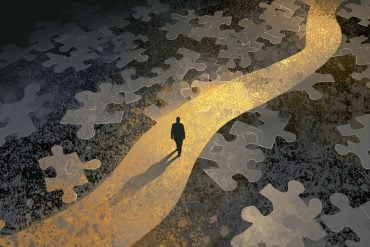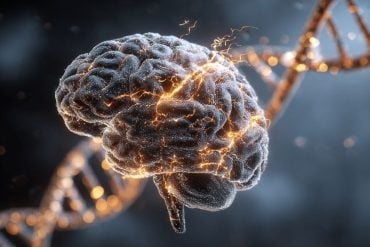Summary: Researchers have developed a new, data driven approach to reveal the topology of networks connected to the circadian clock.
Source: WUSTL.
If you’ve ever experienced jet lag, you are familiar with your circadian rhythm, which manages nearly all aspects of metabolism, from sleep-wake cycles to body temperature to digestion. Every cell in the body has a circadian clock, but researchers were unclear about how networks of cells connect with each other over time and how those time-varying connections impact network functions.
In research published Aug. 27 in PNAS, researchers at Washington University in St. Louis and collaborating institutions developed a unified, data-driven computational approach to infer and reveal these connections in biological and chemical oscillatory networks, known as the topology of these complex networks, based on their time-series data. Once they establish the topology, they can infer how the agents, or cells, in the network work together in synchrony, an important state for the brain. Abnormal synchrony has been linked to a variety of brain disorders, such as epilepsy, Alzheimer’s disease and Parkinson’s disease.
Jr-Shin Li, professor of systems science & mathematics and an applied mathematician in the School of Engineering & Applied Science, developed an algorithm, called the ICON (infer connections of networks) method, that shows for the first time the strength of these connections over time. Previously, researchers could only determine whether a connection existed between networks.
Li and collaborators first tested their method on simulated network of different sizes they created. Next, they tested the method on a network of oscillators — populations of dynamic units that repeatedly fire together, go silent, then fire together again — created in the lab by Istvan Kiss, professor of chemistry at Saint Louis University. When they applied Li’s algorithm to the network of interactions among the synthetic oscillators, the results matched what Kiss had determined through his experiments, finding the same connections in a network of 15 chemical oscillators. Such prediction of this dynamic topology was not previously possible, the researchers said.
Li said this method has a variety of applications beyond cell networks.
“This lays the foundation to analyze real-world complex networks of tremendous size, such as transportation, internet, power grids, and social networks,” he said.
Li also collaborated with Erik Herzog, professor of biology in Arts & Sciences at Washington University who studies the cellular and molecular basis of circadian rhythms in mammals, to determine the connections between cells in a mouse brain. Herzog measured the circadian rhythm from 541 cells from the right and left sides of the mouse brain, then asked Li to estimate how these connections changed over time — something that hadn’t been done in the biology field.

“The connection at one time may be strong, but at another time it may be stronger or weaker, so we can use this data to recover the functional connectivity,” Li said. “If we know this, then we know the network, then we can do more study and investigate over time whether this network will be synchronized or whether specific dynamic patterns will emerge.”
Herzog said ICON would help him and other scientists to understand principles that allow systems to efficiently synchronize.
“For example, we want to define the essential features of networks of cells that keep daily time under different conditions,” Herzog said. “We hope that ICON can map out connections and describe the interactions, such as attraction versus repulsion, of cells at different developmental stages so we can understand more about how circadian systems assemble after birth, adapt to challenges such as winter or summer, and fail to coordinate during stressors such as shift work or flying across multiple time zones.”
In another experiment, collaborator William Schwartz, a former visiting professor of biology at Washington University now at the University of Texas at Austin, tested the method on seven groups of five mice who were housed together for a period of time as social networks. Schwartz measured the oscillations of the mice at the end of the experiment and provided the data to Li, who applied his algorithm to infer results from the data. In the end, both Schwartz and Li found that four of the groups of mice had social synchronization because they had the same body temperatures at the end of their time together. Three groups did not have the same body temperatures and were not socially synchronized.
Funding: This research was supported by funding from the National Academy of Science Keck Future Initiative seed grant; the National Science Foundation; the Air Force Office of Scientific Research (AFOSR); and the National Institutes of Health (1R21-EY027590-01, U01EB021956, NS09536702 and GM094109).
Source: Brandie Jefferson – WUSTL
Publisher: Organized by NeuroscienceNews.com.
Image Source: NeuroscienceNews.com image is in the public domain.
Original Research: Open access research for “Inferring dynamic topology for decoding spatiotemporal structures in complex heterogeneous networks” by Shuo Wang, Erik D. Herzog, István Z. Kiss, William J. Schwartz, Guy Bloch, Michael Sebek, Daniel Granados-Fuentes, Liang Wang, and Jr-Shin Li in PNAS. Published August 27 2018
doi:10.1073/pnas.1721286115
[cbtabs][cbtab title=”MLA”]WUSTL”How Cells Make Connections Could Impact Circadian Rhythm.” NeuroscienceNews. NeuroscienceNews, 27 August 2018.
<https://neurosciencenews.com/cell-connections-circadian-rhythm-9756/>.[/cbtab][cbtab title=”APA”]WUSTL(2018, August 27). How Cells Make Connections Could Impact Circadian Rhythm. NeuroscienceNews. Retrieved August 27, 2018 from https://neurosciencenews.com/cell-connections-circadian-rhythm-9756/[/cbtab][cbtab title=”Chicago”]WUSTL”How Cells Make Connections Could Impact Circadian Rhythm.” https://neurosciencenews.com/cell-connections-circadian-rhythm-9756/ (accessed August 27, 2018).[/cbtab][/cbtabs]
Abstract
Inferring dynamic topology for decoding spatiotemporal structures in complex heterogeneous networks
Extracting complex interactions (i.e., dynamic topologies) has been an essential, but difficult, step toward understanding large, complex, and diverse systems including biological, financial, and electrical networks. However, reliable and efficient methods for the recovery or estimation of network topology remain a challenge due to the tremendous scale of emerging systems (e.g., brain and social networks) and the inherent nonlinearity within and between individual units. We develop a unified, data-driven approach to efficiently infer connections of networks (ICON). We apply ICON to determine topology of networks of oscillators with different periodicities, degree nodes, coupling functions, and time scales, arising in silico, and in electrochemistry, neuronal networks, and groups of mice. This method enables the formulation of these large-scale, nonlinear estimation problems as a linear inverse problem that can be solved using parallel computing. Working with data from networks, ICON is robust and versatile enough to reliably reveal full and partial resonance among fast chemical oscillators, coherent circadian rhythms among hundreds of cells, and functional connectivity mediating social synchronization of circadian rhythmicity among mice over weeks.







